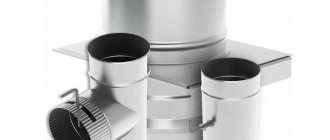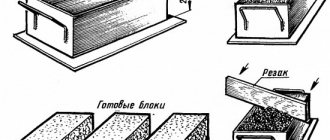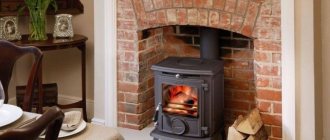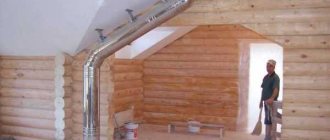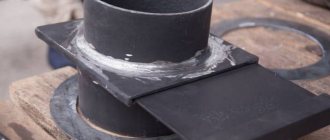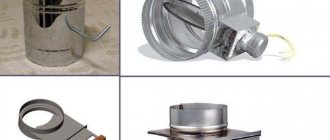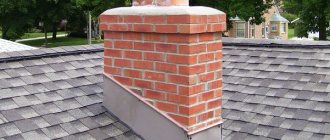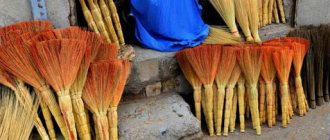The movement of air flows in smoke exhaust channels is subject to the laws of physics, however, with the help of some devices, the draft force can be adjusted. One of such devices is a gate valve - a mandatory attribute of a home or sauna stove.
Let's find out what types of valves there are and whether it is possible to build a damper for a chimney with your own hands if you don't have a factory analogue at hand. The chimney element has a very simple design, but its manufacture requires at least minimal metal processing skills.
Main types of gate valves
Rotary gate.
It is also called a “throttle valve”, which is a metal plate mounted on a rotating axis. The axis, in turn, is attached inside the chimney pipe. This device has a removable rotating disk, but with prolonged use it may become unusable. However, the design of the rotating mechanism allows you to repair and replace it yourself. The advantage of this type of device is its ease of operation. This type of gate does not require constant monitoring by the home owner. Due to the complexity of the DIY design, the rotating mechanism is less often used when laying a fireplace or stove.
The gate design is necessary for wood-burning stoves and heating devices operating on any solid fuel.
Therefore, for a gas boiler, the most practical solution would be to install a rotary mechanism. The temperature of the exhaust gases is less low than when using solid fuel, so the operation of such a mechanism will be the most convenient.
Valve on an insulated chimney
But it is better to refuse to install a rotary mechanism in the bathhouse. The fact is that it will partially allow steam to pass through when closed. And when open, such a mechanism is difficult to clean.
Made of stainless steel, the gate mechanism will not completely block the chimney, but will eliminate the possibility of flames escaping through the ash pan into the room.
There are three options for installing the gate.
- Installing a damper in a fireplace insert. To do this, the damper is mounted at a distance of 1 meter from the heating device, which ensures simple operation.
- The “pipe to pipe” option involves combining the damper with other elements of the heating structure without the additional use of fasteners.
- Installation of a gate valve in a ventilation pipe. But this option is usually used to protect the fan motor from overheating during operation.
But even if the finished kit does not come with this element, you can easily make the gate yourself by choosing the most optimal mechanism option for yourself.
Advantages and disadvantages
Like any engineering solution, a gate has a number of advantages and disadvantages.
Pros:
- Possibility of traction control;
- Fuel economy;
- Dampers help retain heat.
Minuses:
- The devices make it difficult to clean chimneys;
- If installed incorrectly, the gate may jam and negatively affect the movement of gases;
- To make the correct adjustment, you must have some knowledge in the field of smoke exhaust systems.
Differences between retractable and rotary gates
The retractable damper allows you to adjust the working cross-section of the chimney, while the rotary damper only allows you to open or close the pipe. Of course, some tricks are possible - such as securing the hog in an intermediate position in different ways, but the factory equipment does not provide for this. In addition, the rotary gate complicates mechanical cleaning of the pipe.
Finishing the chimney on the roof
Finishing work includes work on sealing the joints of the chimney and roof, equipment for protecting chimneys and ventilation ducts from moisture and thermal insulation work. The important point is to give a beautiful appearance to all structures on the roof.
Chimney lining is done when low-quality brick is used, when there is a risk of destruction under the influence of precipitation. If the draft level is insufficient and the installation height of the chimney meets the requirements stated above, a layer of thermal insulation made of non-combustible materials is laid behind the casing.
Materials and methods of sewing
Regardless of the finishing method, the manufacture of a supporting frame is required, onto which the insulation and sheathing material will be attached. For the chimney, the frame is made only of metal. A profile for attaching plasterboard sheets is perfect for this. The fasteners must also be metal.
The optimal material for cladding is galvanized sheet or corrugated sheet. This type of cladding is low cost and easy to install. The galvanization is fastened with self-tapping screws with silicone or rubber sealing washers placed under the cap.
The chimney can be finished with the same material from which the roof is made
Finishing is also done with natural or artificial stone. In this case, it is necessary to additionally secure the stone to the surface of the chimney using dowels.
Stone finishing perfectly decorates the chimney and gives it the appearance of a small medieval turret
The upper part of the chimneys is protected from moisture getting inside using caps. Since installing a cap tends to worsen traction, the height of the cap should not be less than 150 millimeters. What the cap will be made of depends only on the personal preferences and financial capabilities of the owner of the chimney - it can be made from ordinary galvanized steel or a beautiful forged structure with a weather vane can be used.
Work on lining chimneys must be carried out in accordance with the requirements of fire safety regulations. Combustion products that are discharged from fireplaces, stoves and solid fuel boilers have a high temperature. In gas fuel boilers, the temperature at the outlet of the pipe is much lower, so they can be considered safe. But still, for all types of stoves and boilers, the chimney must provide good draft. The main requirement is to use only materials that do not support combustion.
In the case where the chimney and ventilation ducts are located in the same box, the chimney cut should be located significantly higher than the ventilation cut.
For proper operation of the chimney, it is necessary to clean it from soot, inspect it and eliminate defects at intervals of 2 times a year. The boiler must be operated strictly in accordance with the rules and not used for other purposes.
Why do you need to install a damper?
The installed valve ensures the most efficient operation of the heating equipment. It acts as a regulator damper, the use of which provides partial blocking of the chimney cross-section. So, a gate valve makes it possible to close the smoke channel after the firebox.
The draft is adjusted in this way: by closing the damper, you can reduce or increase the diameter of the chimney.
A gate valve is needed to control combustion in the fireplace insert. Its installation ensures regulation of flue gases and air flows in the chimney of structures.
Types of chimney dampers
- Retractable system. It is made in the form of a horizontal plate; due to its movement, the cross-section of the chimney pipe decreases or increases, regulating the draft. The smooth valve is equipped with a small diameter hole, thanks to which easy and tight movement is carried out in the guide grooves. This type of damper is more common and is used in chimneys whose pipes are made of brick or steel.
- Rotary system (double-wall, throttle). This structure, rotating around its axis, blocks or opens the smoke channel. It is made in the form of a smooth plate, divided in half by an axis and fixed on it. Adjustable by turning both parts in a circle. Used in cases where for some reason it is impossible to install a retractable damper. The disadvantage of the rotating design is that during use, the welding that rotates the plate can break or burn out.
Damper materials can vary, but most often they are stainless steel or cast iron. They are durable, strong, resistant to high temperatures, and the main difference is weight. Cast iron gates are very heavy, which complicates their installation, so gate valves are only inserted into brick pipes. Stainless steel dampers, on the contrary, are universal, lightweight and are used in various types of heating devices.
Which material is stronger
In addition to structural differences, types of gate valves may differ in the material of manufacture. The only possible option is metal, since it is the only one that does not burn or deform at high temperatures, and over time, even in an aggressive environment, does not change its characteristics.
For production, either cast iron or stainless steel is used. It is not possible to build a damper from cast iron yourself, since this requires, at a minimum, a forge. However, you can find both nondescript and beautifully designed cast iron dampers on sale.
Cast iron rotary gate with a comfortable handle. This design is suitable for a brick chimney with a rectangular cross-section, capable of supporting the fairly heavy weight of the device
Steel products look simpler, but their characteristics are similar to their cast iron counterparts. The advantage of steel fixtures is their light weight.
If a cast iron damper for a stove chimney is installed only on a durable, permanent structure, then a steel damper is suitable for any smoke exhaust ducts - brick and steel, rectangular and round, solid and light.
Samples of a galvanized steel damper, chimney cross-sectional diameter – 150 mm. Galvanization, unlike ordinary steel, does not react to moisture (condensation) and does not corrode
When choosing a material, you need to focus on the characteristics of the chimney pipe and the features of the interior.
For a country heating stove, a modest steel valve is sufficient, while for upgrading a Russian stove in a cottage, a custom-made cast iron valve is better suited.
Types of gate valves
There are two main types of gate valves - sliding and rotary (throttle). The design features are clear from the name: the first type works due to the perpendicular movement of the metal plate relative to the chimney pipe.
We recommend that you read: How to make a spark arrestor for a chimney with your own hands?
To increase draft, the damper is moved back and almost completely extends beyond the chimney, and to reduce the flow it is pushed back into the pipe.
Retractable gate
The most popular damper for a retractable type chimney. It compares favorably with other varieties in terms of reliability and ease of use. The retractable gate is a plate with a smooth, even surface, in which there is a special longitudinal hole. It runs along the grooves in the chimney.
This type of valve is installed strictly horizontally. To change the draft force in the chimney, it is enough to move the damper in the desired direction, increasing or, conversely, reducing the cross-section for the pipe.
This option is suitable for steel pipes, but is more suitable for stoves made of brick. Its installation does not require special knowledge or significant effort.
Some models provide a small cut-out area. This ensures the safety of the structure: even if this valve is completely closed, the movement of carbon monoxide in it will continue.
Rotary gate
Another type is a rotary gate. It is a plate made of metal, which is fixed in the central part of the guide by welding.
Dimensions and principle of operation of the rotary gate
Its main portion is located in the inside of the chimney, but the tip should always remain outside. Against the background of rotation of this plate relative to its own axis, the draft in the chimney is regulated.
The disadvantage of this type is the need for fastening by welding. It is this place that is the weak point of the design: the damper will open if the fastening becomes loose.
The rotary gate is characterized by low reliability. But this indicator may vary depending on what it is made from. Most often it is used for installation in steel chimneys. It is also installed in cases where there is not enough space to extend the classic valve.
Cast iron gate
Cast iron dampers have found quite wide application in various types of stoves and fireplaces. The disadvantage of such products is their significant mass. At the same time, cast iron itself has been used for a long time in the production of valves for furnaces. This is explained by its high reliability, durability and strength.
Model range of cast iron gates
Steel type gate
A gate unit made of stainless steel is not the cheapest option. But the design is characterized by high quality and excellent performance characteristics. Its advantages are as follows:
- maintaining furnace efficiency;
- small weight;
- long service life;
- not subject to metal corrosion;
- prevents soot accumulation.
These gates may have different designs depending on the characteristics of the furnace. They are relevant for chimneys made of steel or brick.
Differences between retractable and rotary gates
So far we have been talking about the retractable type of damper on a stove chimney, although there is another type - a rotary one. Let's look at how they differ.
The purpose of both types is the same - to partially or completely block the flow of flue/heated gases. The differences relate to the design.
A retractable model is a metal plate that is fixed in a frame and moves along guides in a horizontal position. There are no strict requirements for the dimensions of the device, since they must correspond to the cross-section of the chimney and completely depend on its parameters.
Thus, the valve consists of two main parts:
- frame , which is fixed in the smoke exhaust duct and is motionless;
- plate moving inside the frame.
Typically, both parts are made from the same material to maintain performance when heated or cooled.
A properly designed and installed damper should never completely block a stove chimney. A small gap is necessary for fire safety purposes.
The design of the rotary (throttle) gate does not extend, but rotates along an axis, as the name suggests.
A round or rectangular plate (depending on the cross-section of the chimney) is fixed on a metal rod, the free end of which extends beyond the channel and serves as an adjustment tool.
The simplest model of a rotary gate with a diameter of 120 mm. Manufacturing material – stainless steel. The smoke exhaust channel is closed by turning the handle with a curved end
Gate valves are considered more reliable and wear-resistant devices. The weak point of the rotary devices is the connection between the rod and the plate, which becomes loose over time and renders the valve unusable.
Gate valve installation
Installation of any type of damper is carried out at the first stages of installing a heating system. Installing the structure on a chimney pipe is not at all difficult. This can be done in three ways:
- Near the fireplace. The device is connected to the chimney pipe at a distance of one meter from the heating devices. This convenient installation of the damper allows you to easily monitor the operation of the gate.
- "Pipe to pipe." This method involves attaching a slide damper to a chimney pipe without the use of additional clamps. The valve is held securely due to its tight connection to the chimney pipe.
- In the ventilation duct. This installation option is mainly used to cool the fan motor.
When constructing stoves and fireplaces, the damper is most often installed using the first method. Gate valves are used for both round and square chimney pipes. Products with a rotating plate are most often installed in chimneys with a cross-section in the form of a circle.
Installing a damper in a brick oven
The gate valve is quite often used for brick kilns. It is installed during the construction of the chimney. Place the valve on the first meter of the pipe. This arrangement of the gate makes it easy to adjust the draft. To install such a gate you need:
- two rows of chimney bricks are laid;
- in the second row an opening of the required size is cut;
- a damper is installed;
- in any brick of the same row a recess is made for a rotary handle;
Next, the next rows are laid
In this case, you should pay attention to the tightness of the fit to the place where the gate is installed. All cracks should be sealed with mortar.
When using such a damper, all safety precautions must be taken into account. During operation of the furnace, under no circumstances should the gate valve be closed. This action will lead to carbon monoxide entering the room. Some models have a special fixing element that prevents the pipe opening from being completely closed.
Without flange connection
Installation may depend on what form is used for the damper in a particular case. For example, in the case of a round shape, the product is inserted directly into the pipe ends. These are the so-called bells. This installation does not require the presence of additional fixing elements. But the joining seam still requires sealing.
The choice of sealant depends on the temperature that will be maintained inside the installation. To solve the problem, heat-shrinkable cuffs with a hot-melt adhesive layer and sealing butyl rubber tapes are often used.
Making a gate valve with your own hands
If the damper is not included with the chimney system, you can purchase it separately or make it yourself. The design of such devices is completely simple, so almost anyone can build a slide valve if they have the skills to work with an angle grinder and a welding machine:
Initially, measurements of the future product are taken
Here it is especially important to correctly size the chimney pipe opening, taking into account every millimeter. The size of the inner side of the frame must correspond to the cross-section of the pipe
The external value of the sides can be determined by adding twenty-five centimeters to the internal indicators. The frame is made from durable stainless steel. The shelves of its corners should be four centimeters each. All frame joints are connected by welding. After this, a hole is made into which the axle will be inserted. To rotate the plate at an angle, holes in the frame are drilled diagonally. For direct rotation, you need to make holes in the center of the parallel sides of the frame. Then the bushings are welded on. They are made from a pipe no more than twelve and a half centimeters long. The rod installed through the bushings should rotate freely. A plate is cut from a stainless steel sheet using a grinder. Its size must correspond to the cross-section of the chimney pipe. All edges of the damper are sanded using a grinder with a disc. The finished plate must be inserted into the frame and attached to the axis using a welding machine, leaving a gap between the frame of more than one centimeter. A limiter is installed on one side of the frame to fix the plate in the required position. A handle is attached to the axis with the help of which you can open and close the damper.
The plate uses steel two or three millimeters thick. All valve parts must be made of the same heat-resistant material. The end of the handle can be decorated with a wooden handle.
The efficiency and safety of heating units depends on the quality of the gate valve and its correct installation. Therefore, when purchasing or independently manufacturing a product, it is necessary to accurately determine the parameters of the chimney and the technical features of the heating system.
Adjusting the temperature of a solid fuel boiler
The efficiency of a heating system depends on a uniform temperature supply. And if in gas and liquid fuel boilers this issue is resolved by continuous fuel supply, then in solid fuel boilers there is no such possibility. And the solid fuel itself, when burned, releases its temperature unevenly: at the beginning and end of combustion, the portions of firewood are smaller, in the middle of the process – more.
A system for regulating the intensity of fuel combustion, that is, the supply of air necessary for combustion, helps to partially solve this problem.
Thermostatic draft regulator
The boiler doors have seals, so air enters under the grates through the lower damper. The opening amount of this blower flap is controlled by a thermostatic draft regulator.
Thermostatic draft regulator. Photo from cotlix.com
The required temperature is set on it, and the regulator itself is mechanically (by a chain) connected to the blower door. If the temperature is insufficient, the regulator slightly opens the blower door; if it is too high, it closes it.
You need to understand that a solid fuel boiler is a very inert device, and the draft regulator controls the combustion process with a large error. Therefore, the entire heating system must be designed taking this feature into account.
Fan and controller
A smoother adjustment of the combustion process is possible using a fan that pumps a specified amount of air into the firebox. The number of revolutions of the device blades is regulated by a controller that takes into account the readings of the temperature sensor and the value of the temperature set by the user.
Shiber
A damper is a damper on a chimney, otherwise called a throttle. The damper is installed after the boiler and blocks the chimney channel. Whether it needs to be installed or not depends on the equipment model. Some types of boilers are equipped with a damper as standard; in other cases, manufacturers may recommend installing an additional damper in the chimney.
The damper allows you to increase the efficiency of the heating device by partially blocking the chimney and reducing the rate of removal of heated combustion products. How much to open or close the damper can only be determined experimentally, because it depends on the outside air temperature, humidity, atmospheric pressure, wind direction and strength.
Properly selected heating equipment, and most importantly, its effective use, will bring warmth into the house, and the owners will only need to supplement it with home comfort.
>
DIY making
The simplicity of the design of the damper plate for the chimney allows you to make it yourself to ensure further regulation of the draft in it.
Option 1. Manufacturing a rotary gate from stainless steel
We offer detailed instructions for manufacturing the damper already with a finished stove heating, when the design is completed, but the damper mechanism was not provided.
To make and install a gate valve with your own hands, you will need the following materials:
- grinder, cutting and grinding abrasive wheel;
- drill;
- tap;
- oil for lubricating the tap when cutting threads;
- hammer;
- vice;
- pliers;
- welding;
- core;
- electrodes for stainless steel;
- compass;
- roulette;
- permanent marker.
The materials you should immediately prepare are:
- stainless steel sheet 1.5 -2 mm thick.
- stainless steel tube with an internal diameter of 6 mm;
- 2 bolts 8mm,
- nail (or metal rod).
When all the tools and materials are prepared, you can begin to carry out the work.
- Measure the inside diameter of the pipe and mark it on the stainless steel sheet using a compass. step 1
- Now, using a grinder, cut out a circle according to the markings made. Step 2
- We try on the cut-out damper and, if necessary, modify it with a grinding wheel until it clearly fits into the pipe. We try on the damper
- Take the prepared stainless steel tube and apply it to the finished circle. Use a marker to measure the size of the flap. We make it smaller than the internal diameter by 3 mm on each side. Step 4
- We cut the pipe with a grinder and a cutting wheel.
- We drill an internal hole in the 6.8 mm tube for threading. When drilling, it is necessary to periodically lubricate the inner surface of the tube with machine oil. Drill out the tube
- We cut an 8mm thread on both sides of the tube with a tap, not forgetting to lubricate the tap in the process. To remove the cutting chips, it is necessary to return half a turn every half turn of the tap along the thread. Step 5
- Now you need to make three holes in the damper. Immediately use a marker to make marks.
- Clamp the tube and the valve in a clamp and weld the tube to the valve through these holes (welded rivets). We start welding from the central hole, then release any one clamp and weld it into the vacant hole. Step 6
- We mark the future holes on the smoker. To ensure that the axis of the holes clearly coincides, wrap the pipe with a tape measure and measure the center horizontally and vertically. Drilling. Making markings
- Assembling the damper into a tube. Step 7
- Making a template for the damper latch. Step 8
- We transfer the markings to the metal sheet. You can use a compass. Step 9
- Mark the middle for the fastener holes, cut and drill according to the markings.
- We weld it to the pipe. We weld the clamp
Option 2. Manufacturing a horizontal sliding gate from stainless steel
For this option, you need to purchase a ready-made factory stainless steel gate valve. The design represents a frame within which the mechanism moves.
- Lay out 2 rows of the stove or fireplace according to the ordering pattern used. horizontal retractable damper
- On the row where the valve will be installed, we cut grooves in the brick. These are small grooves into which the metal element will fit. It is best to use an angle grinder with a wheel for this work. But if you don’t have such a professional tool, then you can get by with a file.
- The damper is installed.
- It is necessary to cut a recess in the side brick for the movement of the damper handle, because during operation it will need to be cleaned of soot. We cover the gate with a row of bricks
- The next row of bricks is laid and all the resulting gaps are well sealed.
As you can see, making a gate does not require much time or much experience. At the same time, this is a very important detail that will significantly increase the efficiency of the boiler or fireplace.
How to make a chimney damper with your own hands?
Many owners are interested in the question: how to make valves in round pipes? For a round or square chimney, you can make a valve yourself. For round structures, a rotary valve is best suited, however, you can also use a horizontal one.
You can make a gate valve yourself, as its design is very simple. Independent production of this shaped element of the chimney structure is relevant if the nearest stores do not have a valve of the required cross-section.
The step-by-step process for making a chimney valve looks like this:
- First of all, it is necessary to prepare the frame in which the retractable plate will be located. It is recommended to make the frame from heat-resistant stainless steel. The width of the steel corner shelves should be from 3.5 to 4.5 cm. The corners are joined using welding equipment.
- At the second stage, you need to make a hole for the axle. It is worth remembering that if you need to make a bolt with a “straight” rotation, then it is recommended to drill a hole at a point that corresponds to the center of the parallel sides of the frame. And for devices that rotate at an angle, the hole is made diagonally.
- Next, you need to install special bushings, which can be made from ordinary pipes. The size of the sleeve should be approximately half an inch, which corresponds to 1.25 cm. To install the tubes, you must use welding equipment. Bushings should not interfere with the movement of the rod axis.
- Then the workpiece is selected for the gate plate. To do this, you will need a stainless steel sheet of appropriate thickness, from which you need to cut a part that fits the cross-section of your chimney. It is worth noting that the thickness of the damper can be higher than 1 mm (for example, 2 or 3 mm).
- At the fifth stage, the finished plate is inserted into the frame and welded to its axis. Experts advise leaving a small gap between the frame and the plate (at least 1 mm).
- The restrictive element is secured, which is necessary to hold the gate plate in the desired position.
- And finally, all that remains is to attach the handle to the axis, which is necessary to regulate the position of the valve.
Installation in a brick pipe
The process is practically no different from the standard assembly of a finished kit. If installation work is carried out by a professional on a brick pipe, then the steps will be as follows:
- Laying down to the last layer of brick.
- Forming a pillow from clay, which cools slightly until it is soft and can be fixed.
- Laying the gate, accompanied by the application of slight pressure to place it in the clay mass.
- Re-placement of clay on the top layer and formation of a new brick row,
- Wait for it to dry and check the operation of the installation (if necessary, you can remove excess clay).
- Covering the resulting cracks.
If the pipe has already been installed, the technician will need to further disassemble it and only then proceed with the steps described above.
Knowing how to make a damper valve in a steel chimney pipe will allow you to entrust all the work to a specialist and not waste unnecessary nerves. And studying and becoming familiar with the main technologies, nuances and features of this process guarantees a high-quality installation check, ensuring the uninterrupted functioning of the smoke damper and the safe stay of people in a bathhouse or private house.
Frequent errors and problems during installation
To install the throttle valve, it is necessary to make markings on the pipe in order to drill holes according to the welded valve structure.
To do this, you need to measure the pipe using a measuring tape and make marks for future holes. After making sure that the marks are symmetrical, use a drill to drill holes for the future rotary handle.
The throttle valve is installed as follows:
- A steel damper circle with a welded tube is inserted into the chimney pipe.
- A metal rod is threaded through the drilled holes in the pipe through a small tube, the end of which is secured with a bolt and nut.
- The end of the rod is bent using pliers for a rotary handle.
Installation of a retractable damper in a brick chimney occurs during the masonry process. To do this, after 6-8 rows of bricks, a layer of cement masonry mortar is applied, on which a wire frame is installed with the open side facing the performer. You need to insert a latch into the frame and bring it into the closed state.
The frame is covered with mortar on top and bricks continue to be laid according to the standard pattern.
Today, there are two main ways to install a damper on a chimney:
- Installation in a fireplace insert. This installation option implies the location of the gate product in close proximity to the heating equipment. As a rule, in this case the distance from the damper to the heating apparatus is 1 meter. This arrangement is very convenient for regulating the valve.
- Connection with other elements of the heating system. In this case, there is no need to use additional locking elements, so this option is quite common. This type of installation can also be called “pipe to pipe”.
The above options for using valves for chimneys and ventilation systems are used everywhere. It is worth noting that today you can find a huge variety of stoves and fireplaces, which differ from each other from a constructive point of view. This variety of heating devices also influenced the range of gate valves.
- Installation of a valve in an insulated area. Under the influence of thermal expansion, the damper may jam;
- Installation of a cast iron part in a metal chimney (cast iron weighs a lot);
- Using too thin steel or stainless steel with a low nickel content for the manufacture of valves. Such a product quickly deforms under the influence of hot gases and can burn out;
- Installation of a gate with a non-smooth surface;
- Installation of a valve without a hole for carbon monoxide release;
- Installation of handles that do not allow monitoring the position of the valve (applies to rotary elements).
Types and designs
A standard chimney damper is a plate that moves forward and backward along the guide rails of a fixed frame. The manufacturing requirements boil down to the fact that the cross-section of the structure must be equal to the diameter or transverse size of the channel for removing combustion products. Both parts of the device are made of the same material, since during heating and cooling the linear dimensions of expansion and contraction must be maintained.
A version of the retractable damper is used in brick chimneys or ceramic pipes. The plate has a small hole to reduce the risk of smoke inhalation. The device is easy to assemble and install.
A rotary valve is a rotating plate on a metal welded rod. The disadvantage is that when completely closed, air passes through the structure.
Types of gate valves
Since chimneys are different, our gate valves are also different from each other. Basically, this difference lies in the form and method of functioning. There are several types of gate valves:
- A horizontal gate valve that retracts. This is the most common type of gate valve. Inside the structure there is a plate that is retractable; it is thanks to it that the cross-sectional area is regulated. Most often, this design is used for brick chimneys. To prevent the smoke channel from being blocked 100% in the closed position of the element, small holes are made in the plate. This is done for a reason, because the creation technology complies with fire safety. The peculiarity of the horizontal gate is its simplicity of design and ease of installation, as well as operating efficiency.
- Rotary gate. It also has a second name - “throttle valve”. The design is radically different from the previous version. It is made in the form of a pipe, inside of which there is a metal plate. Only it does not extend, but is located on a rotating axis. The device is equipped with a removable rotating disk, which becomes unusable over time. However, due to the rotary mechanism design, it is easy to carry out repairs and replace the part yourself. The valve is located inside the chimney pipe. The principle of operation is to rotate the plate located inside. The advantage of this gate valve design is that it is easy to operate. The home owner will not need to constantly monitor the position of the gate.
Since the second option is more difficult to implement, this chimney damper is not made by hand. Most often, it is the first option that is created – a horizontal valve. I would like to note a few more nuances. A gate valve is needed for wood-burning stoves and other heating equipment that runs on solid fuel. If we talk about gas boilers and those operating on liquid fuel, then the damper is needed more in order to protect the chimney structure from the penetration of atmospheric precipitation, debris and animals.
If we talk about installing a rotary valve for a bathhouse, then it is better not to do this. Why? During operation, the structure will partially allow steam to pass through when closed. And it is difficult to clean when open.
There are three ways to install the gate:
- Installation of the product in the fireplace insert. For this purpose, it is installed at a distance of 100 cm from the heating device (stove, fireplace, boiler), which simplifies operation.
- The pipe-to-pipe method is based on combining a gate valve with other elements of the heating system, without the use of additional fasteners.
- Installation of the valve directly in the ventilation pipe. The purpose of such manipulation is completely different. The valve is needed more to protect the channels from the penetration of foreign objects, debris, sediment and animals. This is done to protect the fan motor.
There are two options for how to proceed if you need to install a valve. The first is to simply buy a kit and carry out the installation yourself according to the manufacturer’s instructions. The second is to make a damper for the chimney yourself. We will consider options for creating both a rotary and a horizontal device.
Principle of operation
When the plate moves inside the device, the channel capacity decreases or increases. The further the damper in the pipe is moved, the sooner the smoke is removed and the combustion of the fuel in the stove accelerates. Completely blocking the hole in the chimney allows the heat to remain in the stove and work to heat the room air throughout the day.
The plate can be completely retracted only in a heated hearth, when substances harmful to human health cease to be released. If the valve is closed too early, there is a risk of suffocation among family members. Sometimes failure to comply with this rule leads to the death of people.
Boiler models are produced with built-in baffles, so installation of a damper is not necessary. Other heating units, furnaces, boilers require the installation of a valve. It is installed in ventilation and exhaust pipes.
Chimney deflector (Photo: Instagram / deflector21)
Functions, purpose and characteristics
Being the main draft regulator inside the chimney, the damper regulates the combustion of fuel. To reduce the draft and reduce the intensity of the flame in the firebox, it is enough to close the slide valve. To increase traction, on the contrary, it is necessary to open it.
In fact, a gate is an ordinary metal plate that allows you to regulate traction.
It can be installed both in single-wall and double-wall boiler systems.
If the fireplace and stove are not in use, then during this period the gate valve must be in the closed position.
But on the contrary, it is not recommended to install a valve on a section of a well-insulated chimney pipe. Especially when it comes to double-circuit pipes. When the metal of the inner and outer pipe expands, the gate valve may jam.
So, the main tasks of a gate valve are:
- Function of the draft regulator in the chimney.
- Partial blocking of the chimney channel section.
- Regulator of flame burning intensity in the firebox.
The gate valve is a thin metal plate that is manually adjusted using a special handle. The latter is located outside the chimney pipe so that the user can manually adjust the position of the plate.
Depending on the design and type of damper, it is installed using a special metal frame, or is inserted inside the pipe and fixed with an axial rod.
The damper in the chimney performs the following functions:
- increases traction force in difficult weather conditions;
- increases the intensity of combustion in the furnace due to increased oxygen flow;
- reduces draft when there is a strong hum in the chimney during strong winds;
- saves fuel by reducing combustion intensity;
- prevents heat loss after the heater has warmed up.
What is it and what is it for?
Damper (from the German Schieber - damper) is a device for completely or partially blocking the movement of gases in the chimney. It has been used since the appearance of the first Russian stoves. Made from cast iron or steel. In modern engineering it has found application both in smoke exhaust structures and in ventilation systems.
Damper functions:
- Regulating draft and maintaining heat in the room.
The chimney is closed after use to prevent warm air from being drawn from the room into the chimney. Using a damper, you can reduce or increase the working cross-section of the chimney.
- Saving fuel consumption.
The valve can be used to regulate the intensity of oxygen flow to the flame, and accordingly increase or decrease the efficiency of the heater.
This statement is true only for furnaces and boilers without blowers and forced air supply devices.
How to make a gate valve with your own hands
Let's look at how to make both types of chimney valves - retractable and rotary. Each of them has its own manufacturing and installation nuances. Let's start with the retractable view.
Preparation of materials and tools
To create the simplest model of a retractable gate, galvanized steel is suitable. It is lightweight, thanks to its smooth surface it is easy to clean from soot, and if necessary, the moving part can be easily replaced.
Millimeter steel will not work, as it bends easily, and if deformed, it will be difficult to slide the plate into the chimney. The minimum sheet thickness is 1.5 mm, and preferably 2-2.5 mm
The main tools are a welding machine, electrodes, a grinder, metal scissors (choose depending on the thickness of the sheet), a drill with a grinding disc, metal drills, and a file. It is better to carry out work on a workbench with a vice. Among other things, you will need a sheet of paper for a template, a tape measure, and a marker.
Drawing up a diagram (drawing)
Removing dimensions must be taken seriously, since even a few millimeters can cause the chimney to malfunction. To find out the dimensions of the frame, you should use a tape measure to measure the cross-section of the smoke exhaust duct - it will coincide with the dimensions of the inside of the frame. To this value you should add 20-30 mm on three sides and calculate the outer side of the frame.
Drawing of a damper with a wire frame. A wire frame is more difficult to secure to brickwork than a profile with flat wide sides
In order for the latch to slide out easily, without effort, its width should be slightly narrower than the width of the frame (taking into account the outer sides). To simplify the calculations, it is necessary to draw a design diagram and indicate all possible dimensions, so that in the future, when working with metal, you can navigate by them.
For metal pipes, a flat damper design is usually combined with a chimney fragment located perpendicularly.
Design dimensions for a rectangular pipe. The valve must completely block the chimney, but at the same time have small holes for air penetration, drilled with a drill, or a gap
For brick chimneys, a flat frame made of wire or profile with a valve moving along guides (two parallel sides) is sufficient.
Marking and cutting out parts
Having determined the exact dimensions, we cut out the frame for the gate. If the chimney is small (for example, in a bathhouse or in a summer kitchen), you can use thick wire, bending it in the shape of the letter P.
A more comprehensive frame is a durable corner profile. To make it, we cut out a strip from sheet steel and bend it lengthwise at an angle of 90º. To give the profile the desired shape, in the places where the corners are marked, we cut one of the planes. When folded, we get a frame. We weld the bends.
Next, we cut out the damper itself. It should be approximately 5-10 mm narrower than the width of the frame. We adjust the length so that when closed, only a small fragment of the valve peeks out. It can be decorated in different ways: in the form of an ear with a hole or simply a folded edge.
We clean the edges of the cut gate with a disc so that the closing/opening process is easy and silent. Parts cannot be painted.
Gate valve installation steps
The photo shows the stages of installing a factory-made gate. A homemade device is mounted using the same principle.
Image gallery Photo from In accordance with the furnace diagram, we determine the installation location of the gate valve and mark the bricks that need to be trimmed
We take out the bricks that serve as the basis for installing the damper and cut them to the size of the gate frame with a grinder
To fix the valve we use masonry mortar. We apply it to the installation site, and then to the edges of the frame from above.
The valve “stands” on the same level as the rest of the bricks, so there are no obstacles to further masonry; it is carried out in the usual manner - according to the ordering scheme
Step 1 - determining the installation location
Step 2 - cutting bricks around the perimeter of the hole
Step 3 - planting the gate on the solution
Step 4 - brickwork above the gate
The installation height of the damper largely depends on the design of the stove; in sauna stoves it is lower, in home heating stoves it is higher. The minimum height is 0.9-1 m from the floor, the maximum is about 2 m.
Home manufacturing technology
Qualified specialists always emphasize that even a novice craftsman can make a rotary and retractable gate. After all, in order for the finished product to perfectly cope with its main task, you need to correctly take all the necessary measurements
If the finished damper fits tightly into the chimney, then over time it may jam, as it will be exposed to high temperature. And when there is a large gap between the valve and the pipe, it will be difficult to regulate the intensity of the draft during operation.
Multifunctional butterfly valve
To make this type of gate, you need to use a steel angle of 30x30 mm, as well as durable sheet steel, the thickness of which is at least 1.5 millimeters. The manufacturing process itself consists of several main stages, which must be implemented in strict sequence:
- Initially, you need to take measurements of the inside of the chimney. This is done in order to avoid mistakes during the manufacture of a frame from a corner, which is fixed with a welding machine.
- On one side of the frame, exactly in the center, you need to drill a small hole (7-8 mm in diameter). It will be useful for the rotary axis.
- A similar hole must be made on the other side of the frame.
- The plate for the damper must be cut from a steel sheet. This part must fully correspond to the internal dimensions of the manufactured frame.
- To make a guide axis, you need to take a piece of wire with a diameter of 9 mm and a length that will exceed the size of the frame itself by 7 cm. You need to cut a thread on one side of the wire (a die is best for this task).
- The finished axle is carefully threaded into the holes on the frame and secured with a nut.
- All cuts on the plate are processed with a grinding machine and inserted into the frame.
- At this stage, the master must weld the axle exactly in the center of the plate.
- All that remains is to make a comfortable handle for the guide from high-quality scrap materials.
Universal device
Modern gate valves include the valve itself, as well as a special guide frame. That is why, before starting work, the master must measure the internal cross-section of the pipe or brick chimney. In accordance with the available measurements, a neat rectangle is cut out of sheet steel (5 mm thick). A small longitudinal fold is made on one side, the width of which should not exceed 30 mm.
These manipulations are necessary so that the finished damper can be conveniently pulled out. Each cut must be polished, due to which the dimensions of the product are reduced by 2 mm on each side. Such actions by the technician will ensure free movement of the damper inside the chimney.
When the damper is made for a brick fireplace, the frame itself can be made of thick steel wire, the diameter of which is within 6 mm. During this procedure, the metal blank is simply bent into the shape of the letter P in strict accordance with the existing measurements.
If the chimney has a rectangular shape and is made of steel, then it is better to make the frame from a metal strip 2 mm thick and up to 35 mm wide. The prepared strip is bent lengthwise, leaving a neat gap along the thickness of the plate. Only after this can small cuts be made in two places at an angle of 45° to give the workpiece a U-shape. All gaps in the places of cuts must be butt welded.
To connect the ends of a homemade damper, you need to use two pieces of metal, which should be positioned in such a way that the damper blade can pass freely between them. At the end of all these manipulations, the master should come out with a rectangular frame with grooves for the shutter.
To make a valve in a round pipe, you need to take two identical metal sheets 2 mm thick. Round holes are cut in the center in accordance with the diameter of the chimney. The valve plate must be manufactured separately. After this, the sheets are connected to each other using a welding machine.
It is necessary to weld only three sides around the perimeter so that the holes of the finished valve on the pipe match exactly. A gap of 5 mm must be left between the top and bottom sheets. At this point, the damper manufacturing process can be considered complete, since the craftsman can only insert the valve and secure the finished product to the chimney.
Main functions of a gate valve
The main purpose of the gate valve is to ensure stable operation of the heating system due to good draft. The purchase of chimney pipes involves equipping them with a production damper. If the valve was not included in the kit, you can create the product yourself.
The damper helps direct air flows, accompanying the free outflow of combustion products, so that smoke does not occur in the premises.
Overlap functionality
The traction force can be adjusted by increasing the pipe flow, by extending or rotating the interlayer, or by closing it, returning the disc to its original position.
After everything inside the furnace has burned out, the gate is pushed in all the way, completely blocking the pipe. You should not close the chimney until the coals have cooled, as combustion products continue to be released for some time and there is a risk of suffocation.
